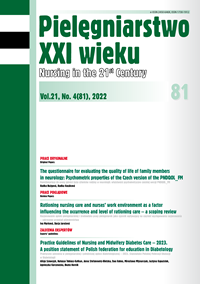Assessment of school stress levels and strategies of coping with stress in high school students
DOI:
https://doi.org/10.2478/pielxxiw-2022-0039Keywords:
stress, youth, stress copingAbstract
ASSESSMENT OF SCHOOL STRESS LEVELS AND STRATEGIES OF COPING WITH STRESS IN HIGH SCHOOL STUDENTS
Aim. To assess the level of school stress, factors infl uencing it and coping strategies among high school students.
Material and methods. The research was conducted online in 2021. The method used was a diagnostic survey at work. Research tool was the original questionnaire and the Mini-COPE scale. The group of respondents was 200 high school students – 130 boys, 70 girls.
Results. Less than half (46.8%) of secondary school students indicated their level of perceived stress as “6” on a 10-point scale, where “0” meant no stress, “10” – the maximum stress. Data analysis showed the most common relaxation methods turned out to be listening to music (92 people) and outdoor walks (65 people). As many as 89 respondents did not use any relaxation methods. The most common stress coping strategies are acceptance, self-focus, and active coping. The least frequently selected option was the use of psychoactive substances..
Conclusions. 1. School stress experienced by secondary school students is moderate. 2. Age and gender do not aff ect the level of stress experienced by high school students. 3. The most common relaxation method among adolescents is listening to music. 4. Acceptance, preoccupation with something else and active coping are the most commonly used strategies for coping with school stress.
References
1. Samardakiewicz M. Psychologia. [w:] Rokicka – Milewska R. red. ABC chorób wieku dziecięcego. Warszawa: Wydawnictwo Lekarskie PZWL; 2011, s. 583-604.
2. Kaczmarska A., Curyło – Sikora P. Problematyka stresu – przegląd koncepcji. Hygeia Public Health, 2016; 4 (51): 317-321.
3. Korczyński S. Źródła uczniowskiego stresu i sposoby sprawowania nad nim kontroli. Problemy opiekuńczo–wychowawcze, 2013; 2: 3-10.
4. Półtorak M. Stres szkolny – skala problemu i jego symptomatologia w postrzeganiu uczniów. Doniesienia z badań. Problemy opiekuńczo-wychowawcze, 2018; 2: 47-58.
5. Michalik-Surówka J. Stres szkolny. [w:] Pilch T. red. Encyklopedia pedagogiczna XXI wieku. Warszawa: Wydawnictwo Akademickie Żak; 2012, s. 1053.
6. Juczyński Z, Ogińska-Bulik N. Narzędzia pomiaru stresu i radzenia sobie ze stresem. Warszawa: Pracownia Testów Psychologicznych; 2012, s. 45-58.
7. Williams M, Morse B, DeGraffenried W, et al. Addressing Stress in High School Students During the COVID-19 Pandemic. NASN school nurse, 2021; 36(4): 227-232.
8. Korczyński S. Stres edukacyjny gimnazjalistów. Prace Naukowe Akademii im. Jana Długosza w Częstochowie Rocznik Polsko-Ukraiński. 2014; 26: 89–110.
9. Park S, Park S, Jang S, et al. The neglected role of physical education participation on suicidal ideation and stress in high school adolescents from South Korea. Int. J. Environ. Res. Public Health. 2020; 17(8): 2838.
10. Leonard NR, Gwadz MV, Ritchie A, et al. A multi-method exploratory study of stress, coping, and substance use among high school youth in private schools. Front. Psychol. 2015; 6: 1028.
11. Van S, Thien V, Tat T, et al. The stress problems and the needs for stress counseling of high school students in Vietnam. Eur. J. Educ. Res. 2019; 8(4): 1053-1061.
12. Gomez A, Calonia J, Huera M. Stress and coping strategies of senior high school students: basis for action plan. Int. Multidiscip. Res. J. 2021; 2(2): 32-38.
13. Półtorak M. Stres szkolny – skala problemu i jego symptomatologia w postrzeganiu uczniów. Doniesienia z badań. Problemy opiekuńczowychowawcze. 2018; 2: 47-58.
14. Racu I, Vlas I. Gender difference in stress at adolescents. Vector European. 2021; 1: 168-172.
15. Singh S, Mani Pandey N, Datta M, et all. Stress, internet use, substance use and coping among adolescents, young-adults and middle-age adults amid the ‘new normal’ pandemic era. Clin. Epidemiology Glob. Health. 2021; 12: 2213-3984.
16. Volanen S, Lassander M, Hankonen N, et al. Healthy learning mind – Effectiveness of a mindfulness program on mental health compared to a relaxation program and teaching as usual in schools: A cluster-randomised controlled trial. J. Affect. Disord. 2020. 260: 660-669.
17. De Witte M, Spruit A, Van Hooren S, et al. Effects of music interventions on stress-related outcomes: a systematic review and two meta-analyses. Health Psychol. Rev. 2020; 14(2): 294-324.
18. Chaudhuri S. The effects of music on stress. Int. J. Adv. Res. 2021; 9(2): 524-538.
19. Inglot-Kulas J, Kloc P. Stres jako antywartość – stres szkolny w opiniach młodzieży szkoły ponadgimnazjalnej. Raport z badań. [w:] Dudzik I., Czuba B., Rejman K. red. Rola wartości etycznych we współczesnym świecie. Wartości etyczne współczesnego człowieka Cz. I. Jarosław: Wydawnictwo Państwowej Wyższej Szkoły Techniczno-Ekonomicznej im. ks. Bronisława Markiewicza w Jarosławiu; 2017, s. 81-93.
20. Talik E. Specyfika stresu szkolnego i strategie radzenia sobie z nim przez młodzież w okresie dorastania. Horyzonty Psychologii. 2011; 1(1): 127-137.
21. Nawalna A, Baran M. Sposoby radzenia sobie ze stresem młodzieży gimnazjalnej zamieszkałej w mieście i na wsi. Problemy Pielęgniarstwa. 2015; 23(2): 197-202.
22. Parikh R, Sapru M, Krishna M, et al. „it is like a mind attack”: Stress and coping among urban school-going adolescents in India. BMC Psychol. 2019; 7: 31.
23. Deklaracja Helsińska Światowego Stowarzyszenia Lekarzy. Etyczne zasady prowadzenia badań medycznych z udziałem ludzi, 1964, http://praca.biol.uw.edu. pl/wpcontent/uploads/2013/06/Deklaracja-Helsinska.pdf (dostęp: 10.04.2020 r.)
Downloads
Published
Issue
Section
License
Copyright (c) 2022 Authors

This work is licensed under a Creative Commons Attribution 4.0 International License.




